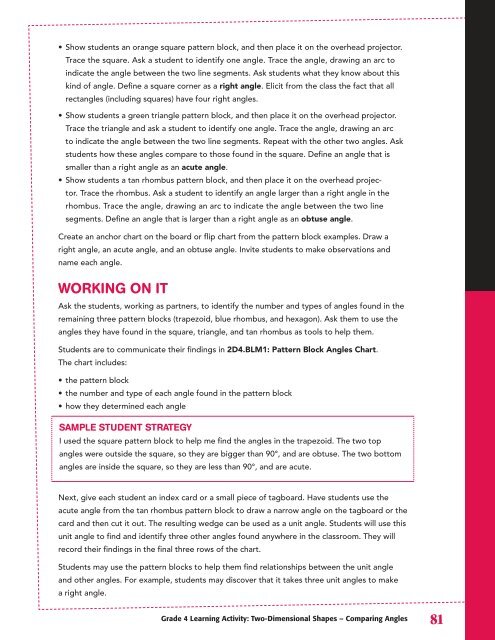Geometry and Spatial Sense, Grades 4 to 6 - EduGains
Geometry and Spatial Sense, Grades 4 to 6 - EduGains
Geometry and Spatial Sense, Grades 4 to 6 - EduGains
You also want an ePaper? Increase the reach of your titles
YUMPU automatically turns print PDFs into web optimized ePapers that Google loves.
• Show students an orange square pattern block, <strong>and</strong> then place it on the overhead projec<strong>to</strong>r.<br />
Trace the square. Ask a student <strong>to</strong> identify one angle. Trace the angle, drawing an arc <strong>to</strong><br />
indicate the angle between the two line segments. Ask students what they know about this<br />
kind of angle. Define a square corner as a right angle. Elicit from the class the fact that all<br />
rectangles (including squares) have four right angles.<br />
• Show students a green triangle pattern block, <strong>and</strong> then place it on the overhead projec<strong>to</strong>r.<br />
Trace the triangle <strong>and</strong> ask a student <strong>to</strong> identify one angle. Trace the angle, drawing an arc<br />
<strong>to</strong> indicate the angle between the two line segments. Repeat with the other two angles. Ask<br />
students how these angles compare <strong>to</strong> those found in the square. Define an angle that is<br />
smaller than a right angle as an acute angle.<br />
• Show students a tan rhombus pattern block, <strong>and</strong> then place it on the overhead projec-<br />
<strong>to</strong>r. Trace the rhombus. Ask a student <strong>to</strong> identify an angle larger than a right angle in the<br />
rhombus. Trace the angle, drawing an arc <strong>to</strong> indicate the angle between the two line<br />
segments. Define an angle that is larger than a right angle as an obtuse angle.<br />
Create an anchor chart on the board or flip chart from the pattern block examples. Draw a<br />
right angle, an acute angle, <strong>and</strong> an obtuse angle. Invite students <strong>to</strong> make observations <strong>and</strong><br />
name each angle.<br />
WORKING ON IT<br />
Ask the students, working as partners, <strong>to</strong> identify the number <strong>and</strong> types of angles found in the<br />
remaining three pattern blocks (trapezoid, blue rhombus, <strong>and</strong> hexagon). Ask them <strong>to</strong> use the<br />
angles they have found in the square, triangle, <strong>and</strong> tan rhombus as <strong>to</strong>ols <strong>to</strong> help them.<br />
Students are <strong>to</strong> communicate their findings in 2D4.BLM1: Pattern Block Angles Chart.<br />
The chart includes:<br />
• the pattern block<br />
• the number <strong>and</strong> type of each angle found in the pattern block<br />
• how they determined each angle<br />
SAMPLE STUDENT STRATEGY<br />
I used the square pattern block <strong>to</strong> help me find the angles in the trapezoid. The two <strong>to</strong>p<br />
angles were outside the square, so they are bigger than 90°, <strong>and</strong> are obtuse. The two bot<strong>to</strong>m<br />
angles are inside the square, so they are less than 90°, <strong>and</strong> are acute.<br />
Next, give each student an index card or a small piece of tagboard. Have students use the<br />
acute angle from the tan rhombus pattern block <strong>to</strong> draw a narrow angle on the tagboard or the<br />
card <strong>and</strong> then cut it out. The resulting wedge can be used as a unit angle. Students will use this<br />
unit angle <strong>to</strong> find <strong>and</strong> identify three other angles found anywhere in the classroom. They will<br />
record their findings in the final three rows of the chart.<br />
Students may use the pattern blocks <strong>to</strong> help them find relationships between the unit angle<br />
<strong>and</strong> other angles. For example, students may discover that it takes three unit angles <strong>to</strong> make<br />
a right angle.<br />
Grade 4 Learning Activity: Two-Dimensional Shapes – Comparing Angles 81

















